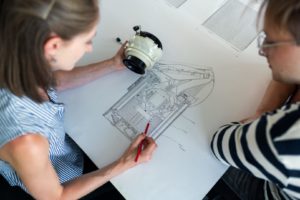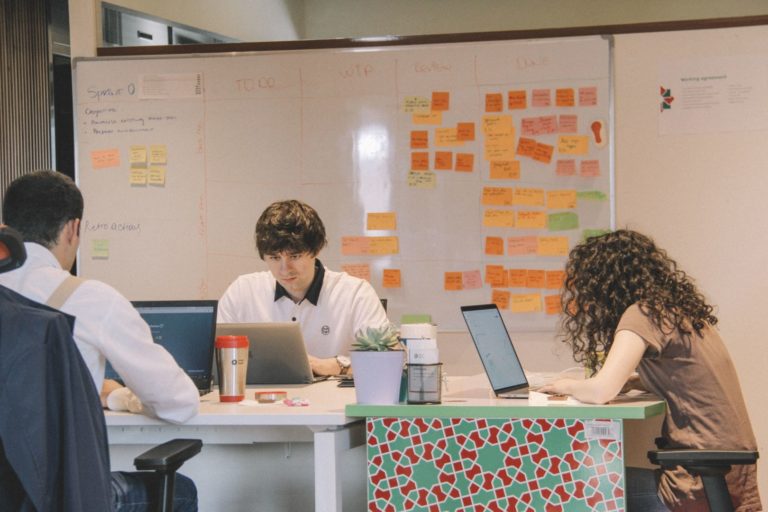When looking for help developing a new product, your first thought might have been to find an engineer. And why not? Everyone knows that engineers design and make things. Not everyone is aware that industrial designers exist.
Then there are those of you who thought you needed a designer and nothing else! Ideas like, my product is simple and doesn’t need to be engineered. Engineering can sound complicated and overwhelming to some. I’ve witnessed arguments between designers and engineers, each claiming the supreme ability to create a product without the other. They are both wrong and there is far more here that just picking a side. Each has their own strengths based on their skills and training.
I have the firm belief that a great product development team has both designers and engineers. And I’m not alone since most companies who create products have both. In my opinion, mechanical engineers and industrial designers are two sides of the same coin. To be successful at developing a product, you need that coin to make a product.
So, let’s break this down and talk about which skill set is best at what and what will be optimal for your project.
The 3 Things you Need to Know
1. Engineers Are More Data & Manufacturing Focused
Generally, engineers are more data and manufacturing focused. Things like sourcing components, building supply chain, working with vendors and suppliers, setting up production, and quality control are all in the engineering world. Aesthetics, branding, emotions, and user experience is not typically their area of expertise.
Not to say there aren’t engineers who can, but their focus is not design, it is engineering. Engineering is also typically in the middle to end of the development process. They don’t create concept renderings or work in the fuzzy front end of the design process.
2. Industrial Designers Are More Focused On the Intangible
Generally, industrial designers focus on user experience, style, and brand. The things that are intangible and affect the way people feel and relate to the product. Industrial designers are often at the front end of the process. Costing, design for manufacturability, and working mechanics are not their specialty.
There are industrial designers out there who know and understand manufacturing processes, sourcing, and can work with the technical part of production. However, most of the industrial designers you see with the cool portfolios are focused on sketches and renders. This is considered concept work and is on the front end of the development process.
3. You want both, and probably need both too
At the end of the day, you someone who’s gone through the entire process and can do everything from the industrial design part to creating engineering drawings for manufacturing and setup supply chains. Now, finding that in one person is rare, as I’ve discovered. I’ve worked in every part of the process but changing careers several times within a few years to get that experience isn’t what most people do.
You will need both skill sets if you want to take your product all the way from idea to a customer. So, it’s likely that you’ll need two people, unless you find someone like me.
Can you work with just one?

Working with a single designer / developer / engineer can be best if you are on a budget.
Ian Peterman, CEO Tweet
You can absolutely work with just one. I’ve seen many successful products come from a single engineer or industrial designer. These are often more simple products and usually hired by a startup or inventor.
With larger budgets, you typically just hire a firm that has both on their team. So yes, this is possible. Would I recommend it unless you absolutely had to? No. I’d definitely recommend making sure you had every skill needed involved in the process to make sure the best outcome possible. However, you can do it.
what's the best option?
It's best to bring in all the right skills into a project, even if it means multiple people.
Ian Peterman, CEO Tweet
With that in mind, how do you choose, or really, should you have to? The answer is no. There are people like me in the world between engineering and design. I like to just call us Product Developers.

There is no degree for this, it comes only with years of experience on both sides of the coin bringing products from a concept to a manufacturable product. It usually means essentially changing careers a couple times to get this experience. However, it pays off in my opinion.
When you want to turn an idea into a product, you should really be looking for a Product Developer. They may have only one degree, though I’ve met some that double majored in industrial design and mechanical engineering. Of course, the cherry on top would be a triple major with electrical thrown in there too. I rely on my team for the electrical myself, I know just enough to be dangerous as they say.
Product Developers can talk about manufacturing processes and stress loads, as well as talk about how a product elicits emotion from a user. Their experience is usually broad, and they truly understand the entire process, concept to production, of a product, whether that product is a baby toy or an industrial laser.
You may find yourself asking the question, when do I need an engineer to do that scary math? Well, when you work with a good Product Developer, they can handle almost anything. If you need real analysis or an engineering stamp, then you can hire a specific engineer for that portion. That level of engineering requires a PE (professional engineer) and typically is only with products that are structural in nature, such as steel barns. For most products, you won’t need that level of engineering.
If you get to a point where an engineer is needed, or a manufacturer should be brought in, a good Product Developer will tell you and help bring on the right people to get your product into production.
Here at the Peterman Firm, we build flexible internal and external teams based on our client’s project needs. This means we have industrial designers, mechanical engineers, and other experts allowing us to be a full scope product development partner. Our teams are experts at developing quality products.
Your Next Steps
Related Conscious Design BLOG Posts
7 Ways to Annoy Your Designer – and You
I’d like to go over a few things that you shouldn’t do with your designer, unless you don’t want to work with them of course.
2 Tools you Should use with Your Developer
When working with a product developer, there are two types of programs you should be familiar with. While there are many options for each one, these two types of programs will help with communication between you and your developer. The first one is one you probably don’t have unless you work with people in 3D often, the other is common, but I’ve run into clients who didn’t use or were unfamiliar with them as well, mostly old school small businesses. 3D viewer You will need this for pretty much any physical product development anymore. While we might start out with sketches and PDFs, which you can make a 3D PDF too now, we quickly move into 3D now. Being able to view your developer’s 3D model from every angle, cross-sectioned, and hiding parts is essential to the review process. Many mid to high-end CAD packages have viewers that work with their software. It is also sometimes a good idea to ask your developer about simple CAD packages that are free/cheap that can open CAD files for you to review. We use SolidWorks primarily, and eDrawings is its free viewer. BLANK Ian Peterman, CEO Tweet File-Sharing Most people think of getting files from the developer, but it’s really a two-way street. You will want to send your initial documents to your developer, as well as feedback and other information in an easy way. Often these files are much larger than what an email can handle, so a file-sharing tool or service best meets these needs. There are many options here, far more than for the 3D viewers, so there is something for everyone. Setting up a shared “folder” with your developer where all files go to will keep things easy and straightforward for both of you and avoid losing any emails with files that you can’t find anymore. For this, we use Google Drive and Dropbox primarily. Talk with your developer, see what programs they use, and make sure everything is compatible. Good developers will set up file sharing through their preferred service, they pay for larger storage and more features than you would probably want to pay for. These tools, in addition to all the other programs and services we all use on an average day, will ensure you and your developer are able to communicate effectively. Your Next Steps Developing Smart Products What do you bring to a developer? Develop a Smart Product Modern Tools Tools of the Design World: Blender Blender Related Conscious Design BLOG Posts Author Mr. Peterman View all posts
5 Common Issues When Hiring a Product Developer
These top 5 issues are avoidable. Keep them in mind when looking for a developer or designer to save you time and money.


